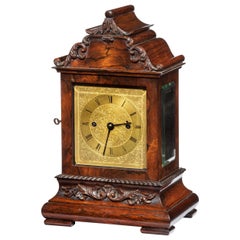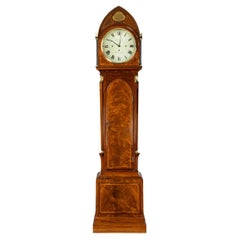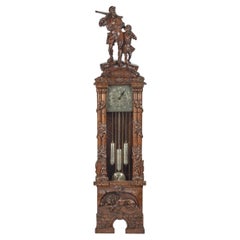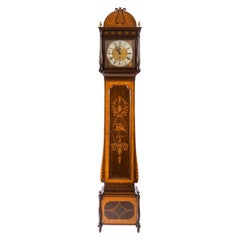Want more images or videos?
Request additional images or videos from the seller
1 of 10
‘Mortar’ Timepiece by Thomas Cole
$33,749.32List Price
About the Item
- Dimensions:Height: 7.25 in (18.42 cm)Width: 8.25 in (20.96 cm)Depth: 12 in (30.48 cm)
- Materials and Techniques:
- Place of Origin:
- Period:
- Date of Manufacture:circa 1840
- Condition:Wear consistent with age and use.
- Seller Location:Lymington, GB
- Reference Number:1stDibs: LU973019666032
About the Seller
5.0
Recognized Seller
These prestigious sellers are industry leaders and represent the highest echelon for item quality and design.
Established in 1982
1stDibs seller since 2013
140 sales on 1stDibs
Associations
LAPADA - The Association of Arts & Antiques Dealers
Authenticity Guarantee
In the unlikely event there’s an issue with an item’s authenticity, contact us within 1 year for a full refund. DetailsMoney-Back Guarantee
If your item is not as described, is damaged in transit, or does not arrive, contact us within 7 days for a full refund. Details24-Hour Cancellation
You have a 24-hour grace period in which to reconsider your purchase, with no questions asked.Vetted Professional Sellers
Our world-class sellers must adhere to strict standards for service and quality, maintaining the integrity of our listings.Price-Match Guarantee
If you find that a seller listed the same item for a lower price elsewhere, we’ll match it.Trusted Global Delivery
Our best-in-class carrier network provides specialized shipping options worldwide, including custom delivery.You May Also Like
Single Fusee Carriage Timepiece By Thomas Cole and James Cole, Retailed By Hunt
By Thomas Cole (Clockmaker)
Located in Amersham, GB
A miniature carriage clock timepiece by Thomas Cole and his brother James Fergusson Cole. The eight day single fusee movement with english lever escapement.
The case is decorated with the ‘Rose and Trellis’ pattern as seen on another of Coles clocks retailed by Edward Dent with the same handle and case construction ( JB Hawkins, “The Hawkins Pictorial Survey of Cole Clocks...
Category
Antique 1840s English William IV Carriage Clocks and Travel Clocks
Materials
Brass, Steel, Ormolu
$14,574
H 5.32 in W 3.15 in D 2.37 in
Thomas Mercer Chronometer Carriage Timepiece
By Thomas Mercer
Located in Amersham, GB
An English gilt brass chronometer carriage timepiece with original travelling case, key and bill of sale. The grained gilt tapering case has a folding handle with bevelled glass panel to the top, bevelled glass panels to the sides and a solid rear plate with hand setting function and start/stop lever, signed Thomas Mercer and numbered 1184, dating from 1974
The silvered dial signed Thomas Mercer, with Roman numerals, subsidiary seconds dial and a state of wind indicator. Blued steel hands. The substantial eight day chain fusee movement with maintaining power, Earnshaw type detent escapement with a free-sprung palladium helical balance spring and heavy bimetallic balance. The original black leather tooled travelling case with lift out front cover is lined in blue velvet and the original safety winding key is stored in the top.
Thomas Mercer was founded in 1858, and became one of the greatest chronometer makers of the 19th and 20th centuries. Ernest Shakleton used a Mercer chronometer on the 1914 Imperial Trans-Antartic Expedition, after the Endurance became trapped and destroyed in the pack ice, he heroically journeyed in a whaleboat, the James Caird, to South Georgia to get help for his stranded compatriots. He navigated with a Thomas Mercer chronometer...
Category
Vintage 1970s British Mid-Century Modern Carriage Clocks and Travel Clocks
Materials
Brass
Early Tripod Table Clock by Thomas Cole with Glass Dome
Located in London, GB
An extraordinary rustic tripod table clock
by Thomas Cole
Retailed by E. White of London
The circular green velvet-clad base supporting three equidistantly spaced brass imitation logs, from which the clock and its mechanism are suspended; housed within a brass bezel conformingly styled as naturalistic logs, the circular etched and engraved gilt dial with elegant blued steel hands, marked at 6 o'clock "E. White, 20 Cockspur St, London", having the hours marked in Roman numerals; the tapered two-tier movement has a six wheel train with five-spoke crossings between spotted plates, the upper section fixed by blued steel screws to the backplate, enclosing a Brocot-style deadbeat escapement incorporating rubies and train to the centre wheel, the pendulum of most unusual design styled as a lidded cauldron over a simulated fire. Complete with a glass dome and key. The front plate numbered “1637.”
London made, circa 1861
Thomas Cole, (1800-1864)
Son of Thomas Cole Snr, a Somerset clockmaker, his history and works are fully recorded in 'Thomas Cole & Victorian Clockmaking' by John B. Hawkins, published 1975, in Sydney. Known as a specialist in making decorative timepieces of the highest quality, Cole exhibited at the Great Exhibition at the Crystal Palace in 1851; he warranted an 'honourable mention' in the Paris Exhibition of 1855 and the London 1862 Exposition International, where he was awarded a medal for 'excellence of taste and design'.
Hawkins discuss Thomas Cole's tripod clocks...
Category
Antique 19th Century English Table Clocks and Desk Clocks
Materials
Brass, Ormolu, Bronze
Large Gilt Brass Engraved Oval Table Clock by Thomas Cole
By Thomas Cole (Clockmaker)
Located in London, GB
A large oval strut clock
By Thomas Cole
The case constructed from gilt brass and designed to be as thin as possible, finely engraved throughout, of substantial oval size, and supported by means of a fold-out foot, the outer frame with floral engraved border, the silvered dial decorated in conforming manner and denoting the hours in Roman numerals with blued steel hands, its centre decorated in foliate patterns; the movement with four turned pillars, spring barrel, steel balance and lever escapement and signed to the backplate by the retailer, also denoted on the dial's cartouche "Thos Boxell, Brighton," and numbered to the rear.
Circa 1860
Dimensions: H: 11 in / 28 cm
Comparative Literature:
Hawkins, J. B. Thomas Cole & Victorian Clockmaking. Woodbridge: Antique Collectors' Club, 1975; p. 90 (item 28), illustrating a related large oval strut clock.
Thomas Cole (1800-1864)
Son of Thomas Cole Snr, a Somerset clockmaker, Cole is known as a specialist in making decorative timepieces of the highest quality. He exhibited at the Great Exhibition at the Crystal Palace in 1851; he warranted an 'honourable mention' in the Paris Exposition universelle of 1855 and the London 1862 International Exhibition, where he was awarded a medal for 'excellence of taste and design'.
Thomas Boxell of Brighton...
Category
Antique 19th Century English Table Clocks and Desk Clocks
Materials
Brass
English Tripod Table Regulator Clock by Thomas Cole, Retailed by Hunt & Roskell
By Thomas Cole (Clockmaker)
Located in Brighton, West Sussex
A Fine English Tripod Table Regulator Clock by Thomas Cole, With Integral Thermometer and Barometer, Retailed by Hunt & Roskell, London
Signed to the dial for the retailer ‘Hunt & Roskell, London.’
No. 1318 /38
The circular six-inch silvered dial with cast bezel, signed ‘Hunt & Roskell, London’, above Roman chapters and blued steel spade hands, set with a large subsidiary seconds dial below XII, the centre finely engraved with scrolling strapwork decoration. The steel winding square protruding through an engraved and shaped plate immediately below 6 o'clock with handset achieved by adjustment to the rear. The movement with tapered plates joined by cylindrical screwed pillars, a two-part backplate, a going barrel, and deadbeat escapement. The pendulum suspended from the apex of the tripod from a G-bracket, with plumb line above, fine regulation achieved by a sliding cylindrical weight on the rod, terminating in a heavy silvered spherical bob secured via Cole's pendulum-locking system.
The case formed of three cylindrical rods set on a gilt and stepped circular base engraved with scrolling foliage, the recessed centre with a semi-circular glazed barometer with silvered register scale, blued steel hand and manually adjustable gilt recording hand. The tilted thermometer within an engraved and gilded surround. Below the tip of the pendulum is a beat scale resting on a bimetallic bar providing thermal compensation, the base resting on three adjustable gilt-metal levelling nuts.
Retaining its original glass dome and brass winding key.
England, Circa 1855.
This fine and rare timepiece by Thomas Cole is a masterpiece of design.
Described by Hawkins in 'Thomas Cole & Victorian Clockmaking' as “the first English table regulator for a gentleman’s library table,” Cole’s strut clock underwent over eight iterations before achieving a design that combined precision with extraordinary elegance.
The use of a tripod to determine the optimal pendulum suspension point is just one of several ingenious mechanisms Cole employed. Three adjustable nuts serving as feet allow for effective levelling of the clock, while a plumb line and bob ensure precise vertical alignment. Relocating the winding square directly beneath the dial eliminates the risk of scratching the surface or damaging the hands, while the inclusion of a thermometer, angled at 45 degrees, effectively conceals the beat scale and pendulum locking mechanism.
Ingeniously designed, the locking mechanism positioned just below the pendulum’s tip includes a beat scale resting on a brass bar that can be raised to secure the pendulum in place. This mechanism also provides thermal compensation through a bi-metallic strip, which automatically raises or lowers the bob in response to temperature fluctuations.
Both inventive and aesthetically striking, this rare clock exemplifies the highly ornamental Victorian timepieces...
Category
Antique 19th Century English Victorian Table Clocks and Desk Clocks
Materials
Brass, Bronze, Steel
$65,453
H 20.87 in Dm 9.45 in
A Strut Clock in The Manner of Thomas Cole by Howell, James & Co.
By Thomas Cole (Clockmaker)
Located in Amersham, GB
This beautiful desk timepiece is a rare strut clock, in the form of a gilded scallop shell, with an engine turned silvered roman dial set behind a bevelled glass with distinctive fle...
Category
Antique 1860s English Baroque Revival Table Clocks and Desk Clocks
Materials
Ormolu
Very Rare 19th Century Coromandel Veneered Year-Running Clock by Thomas Cole
By Thomas Cole (Clockmaker), Achille Brocot
Located in London, GB
A Superb Coromandel-Veneered Mantle Clock
The case constructed of very well-figured Coromandel giving the maximum amount of decorative effect, with gilt bronze accents; the plinth base of rectangular form, with everted stepped corners, and precisely chased gilt bronze figures, two representing Mercury-the god of travel and merchants with his winged helmet and coin purse in hand; the others representing Fortuna-the goddess of luck; the sides glazed, with mooresque arcaded pierced mounts enclosing a vase, in gilt bronze with overlapping palm trees above: the top of domed form with an octagonal platform, surmounted by an architectural dome, its engraved detail and structure reminiscent of Byzantine prototypes. The silvered chapter ring with Roman numerals for the hours, and within an arabesque dial divided into quadrants, with the key aperture at 6 o'clock. Below, the manual calendar, and a semi-circular thermometer. The dial signed by the retailer "Hunt & Roskell / London." The mechanism replaced with a one-year duration movement by Achille Brocot.
English, circa 1860
A closely related clock, by Thomas Cole, though not bearing his signature, with a case of identical form and differing bronze decoration, previously with Butchoff. A third known coromandel-veneered example, also unsigned, is discussed by John...
Category
Antique 19th Century English Table Clocks and Desk Clocks
Materials
Brass, Ormolu
$115,906
H 23 in W 12.5 in D 12.5 in
Early Victorian Gilded Strut Clock in the Style of Thomas Cole
Located in Norwich, GB
Early Victorian Strut clock in the style of Thomas Cole.
Gilded frame with engraved scroll work, oval beaded bezel surrounding a beautiful e...
Category
Antique 1840s French Victorian Mantel Clocks
Materials
Brass
Mahogany Sedan Timepiece by Aubert & Klaftenberger, London
By Aubert & Klaftenberger
Located in Norwich, GB
Fine mahogany sedan timepiece, rectangular case with glazed front giving way to a silvered dial with Roman numerals, finely cut ‘blued’ steel hands and signed ‘Aubert and Klaftenberg...
Category
Antique 1850s English Mantel Clocks
Materials
Mahogany
A Single Fusee Library Timepiece by Phillips Brothers
Located in Amersham, GB
A fine single fusee timepiece dating from the beginning of Queen Victoria’s reign Circa 1840. The eight day movement with anchor escapement with a suspended pendulum bob with top adj...
Category
Antique 1840s English Early Victorian Table Clocks and Desk Clocks
Materials
Brass, Steel
More From This Seller
View AllLate William IV Rosewood Bracket Clock by French, Royal Exchange, London
Located in Lymington, Hampshire
The case carved in high relief with scrolls and an acanthus leaf finial, the gilt face finely chased with further scrolls and signed on the dial, with a discreet/silent lever above t...
Category
Antique 1830s English Mantel Clocks
Materials
Rosewood
Good Quality Regency ‘Egyptian Style’ Mahogany Longcase Clock by John Grant
Located in Lymington, Hampshire
A good quality Regency ‘Egyptian style’ mahogany longcase clock by John Grant, the case surmounted by Egyptian columns with heads and feet of ca...
Category
Antique 19th Century English Regency Grandfather Clocks and Longcase Clocks
Materials
Mahogany
A ‘Black Forest’ linden wood long case clock by Spring of Interlaken
Located in Lymington, Hampshire
A ‘Black Forest’ linden wood long case clock by Spring of Interlaken, the square silvered dial enclosed behind a glazed door within an ornate case, surmounted by a carving of William...
Category
Early 20th Century Swiss Black Forest Grandfather Clocks and Longcase Cl...
Materials
Wood
Unusual Flame Mahogany Long-Case Clock Attributed to Maples
By Maple & Co.
Located in Lymington, Hampshire
An unusual flame mahogany long-case clock attributed to Maples with a Smith & Sons 3-train movement, the case with a stepped base, the hood with two fluted columns and brass fini...
Category
Antique 1880s English Grandfather Clocks and Longcase Clocks
Materials
Mahogany, Satinwood
A Mahogany Long Case ‘tide’ Clock England, c. 1900
Located in Lymington, Hampshire
A very fine mahogany Grandfather clock in the Chippendale taste with extremely rare movement, depicting the rise and fall of the tide.
This long case clock is in the Chippendale ta...
Category
Antique Early 1900s English Edwardian Grandfather Clocks and Longcase Cl...
Materials
Mahogany
'Black Forest' Walnut Clock
Located in Lymington, Hampshire
A very attractive walnut 'Black Forest' clock with mountain rescue dogs,
The clock set into a rocky outcrop surmounted by a pair of dogs, one wearin...
Category
Antique 1880s Swiss Black Forest More Clocks
Materials
Wood
$17,999



